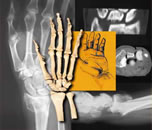(1) How would you describe the fracture?
The fracture is a combination of several fracture types. It has a feature of a volar Barton's fracture as well as a unclassified, complex fracture, with volar (not dorsal) tilt, axial collapse and both coronal and sagittal fracture lines.
(2) What additional considerations are there in this case?
The patient will be needing a cane or walker due to the pulled hamstring and therefore will need to use her hands for support. She will be limited in the use of her left arm due to the radial head fracture. The right wrist needs to be fixed in a way to allow immediate weight bearing.
(3) What are the treatment options? Which one would you suggest ?
The fracture needs reduction, as the current alignment is unacceptable. Closed reduction will probably not be effective and certainly will not be stable, due to the volar Barton's component at least. The options would include a volar plate or an external fixator. I do not feel that percutaneous pinning would be stable, and certainly would not be stable enough for weight bearing. My first option would be a volar plate, but if the comminution is too complex or the fracture cannot be reduced, an external fixator would be a reasonable bailout option.
(4) Would you attempt a closed reduction? Why or why not? What would be the goals of the closed reduction?
Personally, I would not attempt a closed reduction in this case. Sometimes I do a closed reduction, not because I think I can properly reduce the fracture, but because I want to decrease the stretch on the soft tissues. However, in this case, the tissues are not stretched due to the axial collapse and the lack of significant displacement. The median nerve is not at risk. The reduction will also be quite unstable. I would defer reducing this fracture to the OR.
The case continues on the next page >>>


